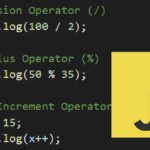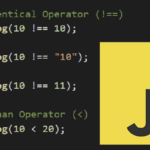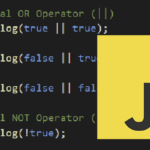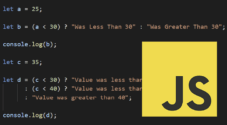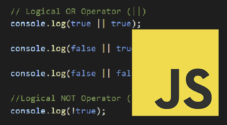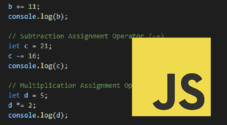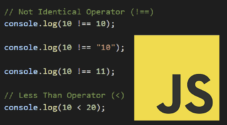In this tutorial, we will be exploring how to use bitwise operators in JavaScript.
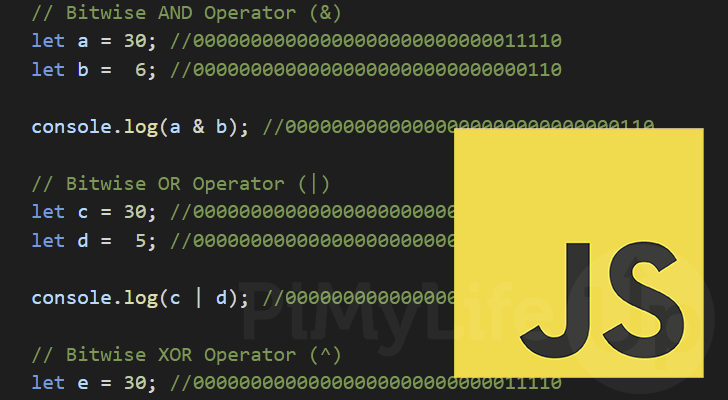
JavaScript’s Bitwise operators are probably the most tricky to understand, especially when you are new to programming or computer science.
While somewhat hard to understand, these operators allow you to perform operations at a binary level, allowing you to manipulate the bits themselves.
Of course, to use bitwise operators, you will need at least a basic understanding of binary numbers. Therefore, we will briefly cover binary numbers within the tutorial to at least get a very entry-level understanding of how all the bitwise mathematics works.
Let us first explore the bitwise operators that JavaScript supports. You can use the table below to see each of the supported operators. Alongside each operator, you will see its name, an example, and a description of what the operator does.
| Operators | Name | Example | Description |
|---|---|---|---|
| & | Bitwise AND | x & y | If both bits are 1, set bit to 1. |
| | | Bitwise OR | x | y | If one of either paired bits is 1, set bit to 1. |
| ^ | Bitwise XOR | x ^ y | If only one of a paired bit is 1, set bit to 1 |
| ~ | Bitwise NOT | ~ x | Inverts all bits, 0 becomes 1, and 1 becomes 0. |
| << | Zero Fill Left Shit | x << y | Shift left by pushing zeroes in from the right, left bits will fall off. |
| >> | Sign-propagating right shift | x >> y | Shift right by pushing copies of leftmost bit from left. Right-most bits will fall off. By copying the leftmost bit, the number should retain its “sign”. |
| >>> | Zero-fill right shift | x >>> y | Shift right by pushing zeroes in from the left. Right-most bits will fall off. |
One important thing to know about JavaScript and its bitwise operators is that it works on all numbers as 32-bit binary. Therefore, even though JavaScript uses 64-bit floating-point numbers for its number system, the value will be converted when you use bitwise operators.
When you use any bitwise operator in JavaScript it will convert the number from a 64-bit system to a 32-bit signed binary number.
Brief Overview of Binary Numbers in JavaScript
Let us start this guide with a very brief overview of how binary numbers are handled within JavaScript.
First, when using bitwise math, JavaScript will use 32-bit signed binary numbers. A signed number means the first bit from the left represents whether the number is positive (0) or negative (1).
A signed number also restricts you to a smaller number. For instance, the limit of a signed 32-bit number is -2147483648 to 2147483647. Whereas the limit for an unsigned number is 0 to 4294967295
A 32-bit number with the value of 0 would look like the following. You can see that all 32-bits are set to 0 since no value is currently set.
00000000000000000000000000000000When counting a binary number, you read from the right, with the right-most bit representing the number 1. Every bit after doubles in value. So bit 2 is 2, bit 3 is 4, bit 4 is 8 and so on.
So if we were to have the number 6, we would need to set both bit 3 and bit 2 to 1, as shown below. Again remember that you write from right to left.
00000000000000000000000000000110Now to make things easier to understand, when we explain JavaScript’s bitwise operator’s math, we will use an 8-bit number, so we don’t have to deal with a ton of leading 0’s. The logic is still the same. We are just dealing with a smaller number.
For example the number 32 could be written like the following in binary using only 8 bits.
00100000However, since JavaScript operates in 32 bits, this number would look like the following in its internal memory.
00000000000000000000000000100000From this, you can see why we will be ignoring the other 24 bits of memory when explaining some of the bitwise math for simplicity’s sake.
Exploring JavaScript’s Bitwise Operators
Over the following sections, we will be exploring each of the bitwise operators supported by JavaScript.
On top of exploring how these operators work, we will also explain how this bitwise math works.
Bitwise AND Operator (&) in JavaScript
The bitwise AND operator (&) works by returning a 1 in each position where both left and right operands contain a 1.
In JavaScript, you write the bitwise AND operator by referencing the left operand, then a single ampersand symbol (&), and finally the right operand.
The value on the left will be compared against the value on the right using the AND operation.
a & bCopyTo give you a better understanding of how this works let us start with this table. This table shows each value an operand can be and the resulting bit from using the AND operator.
| a | b | a AND (&) b |
|---|---|---|
| 0 | 0 | 0 |
| 0 | 1 | 0 |
| 1 | 0 | 0 |
| 1 | 1 | 1 |
This table shows how the bitwise AND operator in JavaScript will handle each bit pair.
Example of AND Binary Math
Let us start by exploring how the bitwise AND operator works outside JavaScript.
To showcase this, we will AND the numbers 30 (00011110) and 6 (00000110). Remember only bit pairs that are both “1” will be carried over to the new number.
1. We need to start by expressing both of our numbers as 8-bit binary numbers. Remember, each bit going from right to left is double the previous bit. So, add the bits that add up to your number.
30 = 00011110
6 = 000001102. Now that we have our values in a binary format, we can AND each bit pair together.
Remember to write a “1” when both bits are 1 and a 0 when they are not.
00011110
& 000001103. The final result shows that we copied over only bit pairs where both values were 1 to the new result.
Converting this number from binary to decimal should leave you with the number 6.
00000110 = 6Example of the AND Operator in JavaScript
Now let us perform this same bitwise AND operation in JavaScript itself. Since JS handles the conversion internally, we don’t have to worry about providing our numbers in binary format.
So let us start by declaring two variables. The first variable will be called “a” and will have the value “30“. The second variable will have the name “b” and have the value “6“.
Within a “console.log()” function call, we will use the bitwise AND operator on both our “a” and “b” variables. The resulting operation will be logged to the console.
let a = 30; //00000000000000000000000000011110
let b = 6; //00000000000000000000000000000110
console.log(a & b); //00000000000000000000000000000110CopyAfter running the above example, you should end up with the following value in your console.
6Bitwise OR Operator (|)
JavaScript’s bitwise OR operator (|) compares each bit pair and will set 1 in that position if either of the bits is 1.
The OR operator is written in JavaScript starting with a left operand, then the pipe symbol (|), and then the right operand. JavaScript will compare the left value against the right operand during the bitwise OR operation
a | bLet us break out another handy table to make this easy to understand. This table will show each occurrence in which the bitwise OR operator sets bits to 1 instead of 0.
| a | b | a OR (|) b |
|---|---|---|
| 0 | 0 | 0 |
| 0 | 1 | 1 |
| 1 | 0 | 1 |
| 1 | 1 | 1 |
Using this table above as a reference, you can see that whenever either of the bits is 1, the resulting bit is 1.
Example of OR Binary Math
To better understand how the bitwise OR operator works within JavaScript, let us explore a simple calculation.
We will use the numbers 30 (00011110) and 5 (00000101) for this calculation. We will bitwise OR both of these values together. If any of the bits in the pair are 1, we will write down 1.
1. Start by expressing both of our numbers as an 8-bit signed binary number.
Remember that we count from the right to the left when reading binary.
30 = 00011110
5 = 000001012. Next, we need to OR our two binary values together. This involves comparing each bit pair and writing down 1 whenever either of the bits is 1.
00011110
| 000001013. After comparing both binary numbers, you should end up with the following result. Converting the number back from binary to decimal should leave you with the value of 31.
00011111 = 31Example of the Bitwise OR Operator in JavaScript
Now that we understand how the bitwise OR math works let us put it to use in JavaScript.
To use the bitwise OR operator in JavaScript, you must use the pipe symbol (|) in between two operands. JS will handle all the grunt work of handling these numbers as 32-bit binary.
For this example, let us create a variable called “a” and assign it the value 30. We will also create a variable called “b” that we will give the value 5.
Finally, we then use the bitwise OR on both our “a” and “b” variables, logging the result using the “console.log()” function.
let a = 30; //00000000000000000000000000011110
let b = 5; //00000000000000000000000000000101
console.log(a | b); //00000000000000000000000000011111CopyThe above example code should produce the following result. This shows you the result of the bitwise OR operation.
31Bitwise XOR Operator (^) in JavaScript
The bitwise XOR Operator (^) in JavaScript compares each binary bit pair and sets a 1 bit in that position when only one of those bits is 1. If both bits are 1, then the XOR operator will return 0 for that position, hence why it’s called eXclusive OR.
You write the XOR operator in JavaScript by writing the left operand, followed by the caret symbol (^), and finally the right operand.
a ^ bCopyLet us write a simple truth table to understand how the XOR operator works. This table will show the only cases in which the XOR operator will set a 1 bit.
| a | b | a XOR (^) b |
|---|---|---|
| 0 | 0 | 0 |
| 0 | 1 | 1 |
| 1 | 0 | 1 |
| 1 | 1 | 0 |
While this table gives you a good idea of how the bitwise XOR operator affects each bit in JavaScript, let us explore the math of this operator and how it works in JavaScript.
Example of XOR Binary Math
Let us quickly take a look at how XOR works outside of JavaScript. This example will help you better understand better what happens when using the XOR operator.
1. For this example, we will be calculating the bitwise XOR of the numbers 30 and 5. However, before doing this we must first express both numbers as binary.
For simplicity’s sake, we will write both of these numbers as 8-bit binary.
30 = 00011110
5 = 000001012. Next, we need to perform an XOR on each of the bit pairs.
Look through each pair of bits and write “1” whenever there is only one “1” in the pair. If both are “0“, or both are “1” then you need to write “0“.
00011110
^ 000001013. After comparing each bit using the XOR method, you should end up with the following result. Converting the binary number back to the decimal format should leave you with the number 27.
00011011 = 27Example of the Bitwise XOR Operator in JavaScript
Now that we have given a quick example of how you can work out the XOR operation yourself, let us put the bitwise XOR operator to use in JavaScript.
For this example, we will declare two variables, one called “a” and one called “b“. The “a” variable will be assigned the value of 30, and the “b” variable the value of 5.
We then use JavaScript’s bitwise XOR operator (^) on these two operands and log the result to the console.
let a = 30; //00000000000000000000000000011110
let b = 5; //00000000000000000000000000000101
console.log(a ^ b); //00000000000000000000000000011011CopyAfter running the above example, you should end up with the result of the XOR operation in your console.
27Bitwise NOT Operator (~)
The bitwise NOT operator (~) in JavaScript inverses every bit within the converted 32-bit signed number.
Since JavaScript uses signed binary numbers, the number will also be flipped from positive to negative during the process. The change in “sign” is a side effect of the bitwise NOT operator flipping each bit..
If a bit is 0, the bitwise NOT operator will flip it to 1. If the bit is 1 then it will be flipped to 0.
The below simple truth table shows the basic way the bitwise NOT operator works within JavaScript.
| a | NOT (~) a |
|---|---|
| 0 | 1 |
| 1 | 0 |
To use this operator, all you need to do is use the tilde symbol (~), followed by your value or variable name, as shown below.
~aCopyExample of NOT Binary Math
Let us first explore how the bitwise NOT operator works outside of JavaScript. This will give you an understanding of what is occurring during this operation.
1. Since the NOT operator only works with a single operand, we will only need one number to show this.
For this example, we will be using the number “5“, which we will convert to a signed 8-bit binary number.
5 = 000001012. With our decimal number converted to binary, we can perform the NOT operation on it. This means for every bit that is 0, we write a 1, and for every bit that is 1, we will write down a 0.
We should note that binary numbers in JavaScript are signed, meaning the left-most bit will be the “sign“. The sign is what tells JavaScript whether this number is negative or positive
~ 000001013. Now, you will end up with the following signed number. If you had a negative number, it would have become positive, and if you had a positive number, it would have become negative.
On top of the changed sign, the value of your number will also be different. For example, positive 5 will not be negative 5 when the binary is inverted, as you will soon see.
Converting a negative signed number back to a decimal number means using “two’s complement” in most modern binary number systems.
11111010 - Signed Negative Number4. We won’t be explaining how exactly two complement works and why, but let us quickly use it to convert our signed negative binary number back to the decimal format.
Start by finding the first “1” from the right.
Once found, invert all the bits to the left, so 0‘s become 1‘s and 1‘s become 0‘s.
Once you have inverted all the bits, you are left with a binary number that you can now read back as a decimal number. Remember to carry over the negative sign to the final number,
11111010
00000110 = -6Example of the Bitwise NOT Operator in JavaScript
Now that you understand how the bitwise NOT operator works in JavaScript let us explore it in some actual code.
Remember that the bitwise NOT operator is represented in JavaScript with the tilde character (~). You use this character before your variable.
With this example, we will declare a variable called “a” and assign it the value 5. This variable is what we will use the NOT operator on.
On our next line, we use the NOT operator on our “a” variable, logging the resulting value
let a = 5; //00000000000000000000000000000101
console.log(~a); //11111111111111111111111111111010CopyUsing the above JavaScript example, you should end up with the following logged to your console.
-6Bitwise Left Shift Operator (<<) in JavaScript
The bitwise left-shift operator (<<) in JavaScript allows you to shift all bits in a number to the left. It achieves this by appending zeroes to the end of the number.
Any excess bit on the left side is dropped off during the shifting process.
Two less-than signs represent the left shift operator. The left operand is the variable you want to shift. The right operand is how many bits you want to shift to the left by.
a << bCopyFor example, if you have the number 1 (00000001) and bit shift it by 1 position to the left, the value would change to “2” (00000010
If you wanted to replicate this behavior without using bitwise operators, it would be the equivalent of using the following math.
x * (2 ** y)You would multiply your value by 2 to the power of y. “y” in this case would be how many places you would want to shift your bits to the left. Computation-wise, shifting the bits is a lot faster.
Quick Explanation of the Left Shift Operator
Bitwise shifting can be somewhat confusing to understand at first but is very straightforward.
Before we show how the left-shift operator works in JavaScript, let us explain it outside of it.
1. Let us take the number 1 and convert that into an 8-bit signed binary number.
The value of 1 means we only have the far-right bit set to “1“, as shown below.
1 = 000000012. Now, let us shift this binary number to the left (<<) by one bit.
We do this by deleting the far-left bit (0 in our example) and adding a new “0” bit on the right side. From this, you can see how our number 1 in binary had its value changed.
00000001 << 1
00000010 - Value shifted to Left by 1 bit3. If we were to convert our shifted binary value back to the decimal format, you can see that our value has now changed from “1” to “2“.
Now, if we were to shift our original 1 value by two places, we would have ended up with the value “4” instead, as our bit would now be in the third position.
00000010 = 2Example of the Bitwise Left Shift Operator in JavaScript
Let us show you a quick example of how the left-shift operator is utilized within JavaScript. To showcase this, we will take the number 7 and shift its bits to the left by two.
At the top of this script, we declare two variables with the names “a” and “b“. The “a” variable is the variable we will be shifting, and we will assign it the value 7.
The “b” variable is the number of bits we want to shift our number by, which we will set to 2.
Finally, we left-shift the “a” variable by the “b” variable, logging the result to the console.
let a = 7; //00000000000000000000000000000111
let b = 2; //00000000000000000000000000000010
console.log(a << b); //00000000000000000000000000011100CopyAfter running the above JavaScript example, you will have the following value.
28Bitwise Sign-Propagating Right Shift Operator (>>)
JavaScript has two versions of the bitwise right-shift operator (>>). The first of these is the “sign-propagating right-shift operator”, this operator is designed to preserve the “sign” bit.
The bitwise sign-propagating right-shift operator is used in JavaScript by using two greater-than operators (>>). The left operand is the variable or value you want to shift, and the right operand is how many bits you want to shift it by.
a >> bCopyThis operator preserves the sign by copying the left-most bit and pushing that in from the left. JavaScript will drop any excess bit on the right.
Quick Overview of the Bitwise Sign-Propagating Right-Shift Operator
Before we show how the sign-safe bitwise right-shift operator works in JavaScript, let us explore what is occurring behind the scenes.
1. For this example, let us take the number -7 and convert it to an 8-bit binary number to make this easier to explain.
Suppose this converted number looks weird to you. It’s because we are using two’s complements. This means starting from the first “1” from the right, we flip each bit to it’s opposite. Converting the number to its signed negative equivalent.
7 = 0000111
-7 = 11110012. Now, if we used JavaScript’s Bitwise-sign propagating right-shift operator on our “-7” value and shifted to the right by two bits, the following would happen.
First, remove the two far-right bits from your binary number. Since we are shifting by two bits, these will need to be dropped.
Next, make a note of the far-left bit. In our case, this is a “1“, meaning we add two “1” bits to the start of the number, shifting the overall value to the right.
If your left-most bit were a “0“, then that would be shifted in from the left instead.
1111001 << 2
1111110 - Shifted to right by 2 bits. Left bit is replicated and shifted in3. Let us now unravel our number to see how shifting the value by two bits affected its value.
Thanks to us following JavaScript’s bitwise signed right-shift operator’s logic, it will still be a negative number. Since it is still a negative number, use the two’s complement logic to convert it back.
Find the right-most “1” bit, and flip every bit after that. So a 1 becomes a 0, and a 0 becomes a 1.
1111110
00000104. Finally, reading our binary value and carrying over the “sign” bit, we ended up with the following negative value.
With this, you can see how the right shift changed our value from -7 to -2.
0000010 = -2Example of the Bitwise Sign-Propagating Right-Shift Operator in JavaScript
For our first example, let us explore how JavaScript’s signed bitwise right-shift operator handles a negative number.
To show how this works, we will be using the number “-7” (a) and shifting it to the right by 2 (b) bits. Thanks to preserving the sign of our number, it will remain a negative number after the shift.
We shift our “a” variable’s binary value to the right by the amount stored in the “b” variable. The result of the sign-propagating right-shift operation is logged to the console.
let a = -7; //11111111111111111111111111111001
let b = 2; //00000000000000000000000000000010
console.log(a >> b); //11111111111111111111111111111110CopyBelow you can see the result of this bitwise operation within JavaScript. You can see how the bitwise operation adjusted the value while preserving the sign.
-2CopyUnsigned Bitwise Right Shift Operator (>>>) in JavaScript
The final bitwise operator that JavaScript supports is the unsigned right-shift operator (>>>).
This operator is represented by three greater-than signs (>>>). The operand on the left will be shifted by right value. Zeroes will be pushed from the left, with excess bits on the right being dropped.
a >>> bSince this operation works without regard for a “signed” number, a negative value will become a rather significant positive value.
Quick Overview of the Unsigned Right-Shift Operator Outside of JavaScript
Let us give you a better idea of what the unsigned right-shift bitwise operator does in JavaScript.
As mentioned before, this operator pushes 0’s in from the left, meaning it will not respect the sign of your number
1. Let us showcase this by starting with the number -7 and converting it to a binary number that we can work with.
We will be sticking to a small 8-bit binary number to make this easy to explain. Since this is a negative number, we will be using two’s complement.
7 = 0000111
-7 = 11110012. Now that we have our binary number, let us perform an unsigned right-shift operator to this number.
We will be shifting this number by two bits to the right. Being unsigned means, we will be adding 0‘s from the left side.
Start by dropping off the two far-right bits from the number. These bits will drop off during the unsigned right shift.
Next, add two 0‘s to the front of your binary number, shifting its value to the right.
1111001 >>> 2
0011110 - Unsigned shift to the right. '0' bits added3. The first thing you will notice is that the sign of our number has now been moved as 0‘s were pushed. This means our number is no longer negative, so you cant use two’s complement to unravel it.
You just need to read the number back as you normally would, counting from right to left. However, you will see that the number is drastically different.
This value difference is amplified even more on the full 32-bit binary that JavaScript uses for it’s bitwise operations.
0011110 = 30Example of the Unsigned Right-Shift Operator in JavaScript (Positive Number)
Let us start by showing how an unsigned right-shift operator works in JavaScript when used on a positive number.
We will start our script by declaring a variable called “a” and assigning it the number 10. Additionally, we will be defining a variable called “b” and assigning it the number 3.
After we have declared those variables, we utilize the unsigned right-shift operator (>>>). We use this operator to shift our “a” variable to the right by the value stored in the “b” variable.
The result of this bitwise operation is logged to the console using the “console.log()” function.
let a = 10; //00000000000000000000000000001010
let b = 3; //00000000000000000000000000000011
console.log(a >>> 3); //00000000000000000000000000000001CopyThe code above will log the following value to the console.
1Example of the Unsigned Right-Shift Operator in JavaScript (Negative Number)
We can show you how the unsigned right-shift operator will affect a negative number in JavaScript. As we mentioned earlier, since this operator pushes in 0‘s, it will break the “sign” bit.
At the top of this example script, we will define two variables. The “a” variable will have the value -7. With the “b” variable, we will assign the value 2.
By using the unsigned right-shift operator (>>>), we will shift our “a” variable to the right by the amount stored in the “b” variable.
Like our other examples, we log the result of this bitwise operator to the console.
let a = -7; //11111111111111111111111111111001
let b = 2; //00000000000000000000000000000010
console.log(a >>> b); //00111111111111111111111111111110CopyBelow you can see how JavaScript’s bitwise unsigned right-shift operator destroyed the “sign” of the number, turning it into a large positive number.
1073741822Conclusion
Throughout this guide, we have shown you how to use bitwise operators in JavaScript.
Bitwise operators allow you to manipulate numbers at a binary level using various methods. We have explained each of these operators, so you should have a decent idea of what is occurring.
Please comment below if you have any questions about bitwise operators.
Be sure to check out our other JavaScript tutorials to learn more. We also have guides for other programming languages if you want to learn something new.
